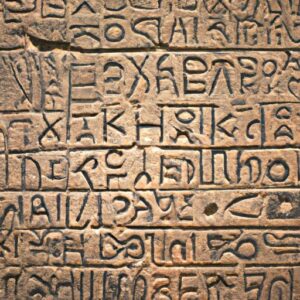The Ramayana, a timeless epic that has captured the hearts and minds of millions, is an enchanting tale of love, duty, and valor. Passed down through generations, this ancient scripture holds immense cultural and spiritual significance. As we dive into the depths of this epic, a question arises: who wrote the Ramayana?
A Brief Overview of the Ramayana
Before we embark on our quest to discover the author of the Ramayana, let’s take a moment to appreciate the magnitude of this cherished tale. The Ramayana narrates the extraordinary journey of Prince Rama, his devoted wife Sita, and the loyal Hanuman as they navigate a world filled with challenges and triumphs. It is a saga that delves into the complexities of human emotions, showcases the triumph of good over evil, and imparts timeless wisdom.
The Importance of Knowing the Author
Understanding the author of a literary masterpiece like the Ramayana is crucial in unraveling its historical and cultural significance. The author’s identity sheds light on the context, influences, and motives behind the creation of this epic. It offers us a window into the time and society in which it was written, enriching our understanding of the values and beliefs of that era.
Introduction to the Main Keyword – “who writing ramayana“
As we delve deeper into the layers of the Ramayana, the question “Who wrote the Ramayana?” emerges as a captivating enigma. Unraveling this mystery not only satiates our curiosity but also offers insights into the diverse perspectives and interpretations of this timeless tale. Join me on this captivating journey as we explore the various theories and possibilities surrounding the authorship of the Ramayana.
In the next section, we will delve into the traditional author of the Ramayana – Valmiki, and uncover the remarkable role he played in shaping this epic narrative.
Valmiki – The Traditional Author
Background information on Valmiki
Valmiki, a revered sage in Hindu mythology, is widely regarded as the traditional author of the Ramayana. Born as Ratnakara, a hunter-turned-sage, his transformation into Valmiki symbolizes the power of redemption and the potential for change within every individual. Valmiki’s remarkable journey from a life of violence to becoming the harbinger of one of the greatest epics in history is a testament to his spiritual evolution.
Valmiki’s Significance in Hindu Mythology
Valmiki’s influence extends beyond his role as the author of the Ramayana. He is revered as the “Adi Kavi,” meaning the first poet, highlighting his immense importance in the realm of literature. His contributions to the literary world go beyond the Ramayana, as he is also believed to have authored other scriptures and poems. Valmiki’s status as a revered sage solidifies his significance in Hindu mythology.
Valmiki’s Role as the Traditional Author of the Ramayana
Valmiki’s authorship of the Ramayana is deeply ingrained in the traditional narrative. According to popular belief, it was Valmiki who transcribed the divine story of Lord Rama, making him the medium through which this epic found its lyrical form. His meticulous retelling of the epic not only immortalized the heroic deeds of Rama but also added depth and emotional resonance to the characters and their experiences.
Analysis of Valmiki’s Writing Style and Contributions to the Epic
Valmiki’s writing style is characterized by its lyrical beauty and emotional depth. His vivid descriptions, poignant dialogues, and introspective musings breathe life into the characters and evoke a range of emotions within the readers. Moreover, Valmiki’s profound insights into human nature and moral dilemmas offer invaluable life lessons that transcend time and resonate with readers even today. His contributions to the Ramayana have made it a timeless masterpiece that continues to captivate and inspire people across generations.
In the next section, we will delve into the controversies surrounding the authorship of the Ramayana, exploring alternative theories and shedding light on the diverse perspectives that exist.
Controversies Surrounding the Authorship
The authorship of the Ramayana is a topic that has sparked intense debates and controversies over the centuries. As the epic has traversed through diverse cultures and regions, it has undergone numerous adaptations, resulting in different versions and interpretations.
Different Versions of the Ramayana and Their Authors
One of the primary sources of controversy surrounding the authorship of the Ramayana lies in the existence of multiple versions of the epic. Each version carries its own unique perspective, nuances, and even authors. These variations can be attributed to the oral tradition of storytelling and subsequent written adaptations.
Some notable versions of the Ramayana include Valmiki’s original composition, the Adhyatma Ramayana, the Tulsidas Ramayana, and the Kamba Ramayana. Each version was authored by different individuals, each contributing their own creative flair and cultural influences to the narrative.
Debates Over Valmiki’s Authorship
Valmiki, the revered sage and poet, is traditionally credited as the author of the Ramayana. His version, known as Valmiki Ramayana, is considered the original text that laid the foundation for subsequent adaptations. However, even Valmiki’s authorship has not been without its share of debates.
Some scholars argue that Valmiki merely compiled and refined an existing oral tradition, rather than creating the narrative from scratch. They propose that the Ramayana was a collaborative effort, incorporating stories from various sources and poets of that time. This perspective challenges the notion of a single author and highlights the collective nature of this ancient epic.
Mention of Alternative Theories and Claims
In addition to the debates surrounding Valmiki, there are alternative theories and claims regarding the authorship of the Ramayana. Some scholars propose that the epic was an amalgamation of contributions by multiple poets and writers, each adding their own flavor to the narrative. Others suggest that the Ramayana was a collective creation, emerging from the collective consciousness of a society deeply influenced by its cultural and spiritual beliefs.
These alternative theories and claims offer a fascinating glimpse into the complexity of the Ramayana’s authorship. They emphasize the dynamic nature of this epic and highlight the multitude of voices that have shaped its rich tapestry.
In the next section, we will explore the role of Sage Narada, a revered figure in Hindu mythology, and his potential influence on the writing of the Ramayana.
Sage Narada – The Divine Inspiration
Introduction to Sage Narada’s Importance in Hindu Mythology
In the realm of Hindu mythology, Sage Narada holds a position of great reverence. Known for his celestial wisdom and divine insights, he traverses the cosmos, imparting knowledge and guidance to both gods and mortals. His presence in the Ramayana brings a touch of ethereal enchantment to the epic.
The Role of Sage Narada in Inspiring the Writing of the Ramayana
As we explore the authorship of the Ramayana, we encounter the intriguing role played by Sage Narada in inspiring its creation. Legend has it that Narada, with his profound understanding of the universe, recognized the need for this immortal tale to be shared with the world. He approached the sage Valmiki, who would become the traditional author of the Ramayana, and inspired him to embark on this monumental literary endeavor.
Narada’s divine intervention ignited the creative spark within Valmiki, compelling him to pen the magnificent saga of Rama and his extraordinary journey. It is said that Narada’s divine blessings and insights infused the Ramayana with a unique blend of wisdom, spirituality, and poetic beauty.
Analysis of Narada’s Influence on the Narrative and Characters
Narada’s influence on the Ramayana extends beyond mere inspiration. His celestial wisdom and guidance are embedded within the very fabric of the narrative, shaping the trajectory of events and the development of characters. Through his interactions with the protagonists, Narada imparts invaluable lessons and moral teachings that guide Rama, Sita, and other key figures towards righteousness and self-realization.
Moreover, Narada’s interventions often serve as catalysts for pivotal moments in the epic. His divine presence adds depth to the narrative, infusing it with elements of mysticism and spiritual significance. It is through Narada’s interventions that the Ramayana transcends the boundaries of mere storytelling, transcending time and space to touch the hearts and souls of countless generations.
In the upcoming sections, we will explore other potential authors and influences on the Ramayana, shedding light on the diverse perspectives that have shaped this beloved epic.
Other Possible Authors and Influences
Mention of other potential authors of the Ramayana
While Valmiki is widely considered the traditional author of the Ramayana, it is important to acknowledge that there are alternative theories proposing other authors. Various regional adaptations and retellings of the epic have given rise to different names associated with the composition of the Ramayana. Scholars have suggested that authors like Tulsidas, Kamban, and Madhava Kandali might have contributed to the diverse versions of this beloved tale.
Discussion on regional variations and authors
The Ramayana’s popularity and timeless appeal have transcended geographical boundaries, leading to numerous regional variations. Each region has added its own flavor and nuances to the epic, often attributing authorship to local poets and scholars. For instance, the Ramcharitmanas by Tulsidas holds immense significance in the northern parts of India, while Kamban’s Ramavataram is celebrated in the southern region. These regional adaptations not only showcase the cultural richness but also reflect the deep-rooted connection that people feel towards the Ramayana.
Influence of oral traditions and folklore on the Ramayana’s writing
In addition to individual authors, the Ramayana’s composition was influenced by oral traditions and folklore. Before the advent of written scriptures, ancient societies relied on the spoken word to pass down stories through generations. The Ramayana, too, was initially transmitted orally, allowing for improvisation and adaptation along the way. These oral traditions, infused with local folklore, played a significant role in shaping the narrative, introducing variations, and embellishing the characters and events of the epic.
By acknowledging these alternative authors and the influence of oral traditions, we gain a deeper appreciation for the multilayered nature of the Ramayana’s creation. It highlights the dynamic nature of storytelling, where multiple voices intertwine to create a tapestry of interpretations that continue to captivate and inspire us to this day.
[Please provide the next section’s outline.]
Conclusion
In the vast realm of the Ramayana, the question of who wrote this magnificent epic has intrigued scholars and enthusiasts alike. While Valmiki stands as the traditional author, alternative theories and regional variations have added layers of complexity to this age-old query.
The importance of recognizing the multiple influences on the creation of the Ramayana cannot be understated. Whether it was Valmiki’s divine inspiration from Sage Narada or the contributions of various regional authors, each perspective brings a unique flavor to the narrative, enriching its cultural tapestry.
As we explore the authorship of the Ramayana, we are reminded of the fluid nature of storytelling. The epic has evolved over time, influenced by oral traditions, regional adaptations, and the creative endeavors of countless individuals. It is a testament to the power of storytelling to transcend boundaries and unite diverse communities.
In our quest to understand the author of the Ramayana, we embolden ourselves to embrace the multitude of perspectives that shape this timeless epic. By doing so, we not only deepen our appreciation for the rich tapestry of Indian literature but also recognize the universal truths and timeless wisdom enshrined within the pages of this magnificent saga.
So, who wrote the Ramayana? Perhaps it is not a singular answer, but rather a collective effort of countless individuals who have contributed to its legacy. As we continue to explore the depths of this epic, let us marvel at the beauty of storytelling, for it is through the power of words that the Ramayana continues to captivate and inspire generation after generation.
Join me in celebrating the magnificence of the Ramayana, a literary treasure that transcends time and space, connecting us to our ancient roots and reminding us of the enduring power of myth and legend.





